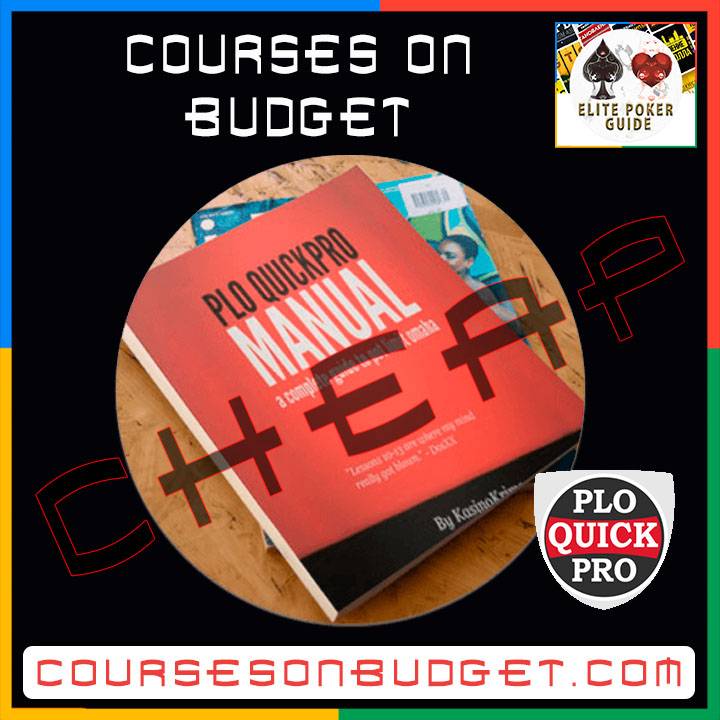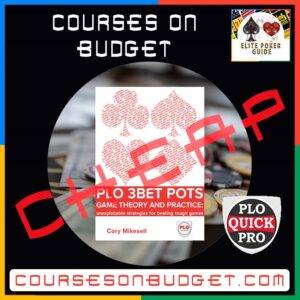What is a PLO QuickPro Manual for Cheap?
The PLO QuickPro Manual is THE DEFINITIVE PLO BOOK for anyone who wants to learn how to win money playing PLO.
Combining world-class PLO theory with hand history analysis from WSOP Champion John Beauprez and over 300 of his students, this comprehensive guide teaches beginning and transitioning NL players how to master the fundamentals, develop a consistent win rate, and move up in stakes.….
If you can say “YES” to any of these questions…
✅ … I believe the QuickPro Manual is a PERFECT fit for you
✅ Are you a beginning player looking to learn the game properly, before you develop bad habits?
✅ Are you a transitioning No-Limit player who wants to feel as comfortable playing PLO as you do in No-Limit?
✅ Are you a winning player looking to plug leaks, raise your NSDW, & learn the lines that print money against even the toughest regs?
✅ Are you a struggling low-stakes player who wants to develop a consistent winrate, so you can finally move-up in stakes?
✅ Are you a live player who wants to learn deepstack strategies, and how to capitalize on soft live PLO action?
If any of the following apply to YOU…
❌ … I don’t believe the QuickPro Manual is a PERFECT fit for you
❌ You Are A Nosebleed PLO player making $10k+/mo already
❌ You’ve never played a hand of PLO in your LIFE
❌ If you enjoy watching PLO but don’t have aspirations of making money from it
❌ If you are exclusively an NL MTT or cash game player
Here’s What You Get
✅ PLO From A to Z: Build a solid framework that helps you crush live and online cash games, and MTT’s
✅ 275 Pages of Battle Tested Theory: Proven PLO theory that’s helped 1000’s of players crush the small stakes and beyond
✅ Insight from 300+ Students: Advice, insights, and feedback from 300+ students and players at your fingertips.
✅ 50+ Hand Histories: Carefully selected hand histories to illustrate the most common concepts you’ll encounter in today’s PLO games.
✅ Special Chapters on Advanced Strategies: Specific chapters on advanced play strategies including Profitable Postflop Scenarios, Three-Betting, Bluffing With Blockers, and River Play.
PLO QuickPro Manual Index:
14 Chapters Providing You With A Comprehensive PLO Education
Chapter 1: Core PLO Concepts
Learn the six Core PLO Concepts that are essential for building a winning strategy. Find out the differences between PLO and NL, and how you can take advantage of the closer equity matchups in PLO.
Chapter 2: Creating Profitable Postflop Scenarios
One of the flagship lessons, CPPS teaches you how to win without the cards first, by breaking down the most important elements for any postflop situation: “The Big Three”. Follow along as I guide you through the psychology of position, and then wrap it up with some hand history discussion.
Chapter 3: Hand Selection and Opening Ranges
In this lesson, we discuss the qualities to look for in a starting hand, and how to decide whether or not to open from every position at the table. Topics discussed include things like table dynamics, position, and adjusting to different opponent types. Learn how to distinguish between wraps, in addition to some discussion on combinatorics.
Chapter 4: To Raise, or Not to Raise?
Here we identify the most common mistakes made in limped pots, while identifying the ideal hands for isolating and limping behind.
Chapter 5: Three-Betting
Used properly, three-betting can be one of the most powerful weapons at your disposal at the tables. But 3b’ing too often can turn you into a spew-monkey, so in this lesson, we’ll cover the who/what/where/when and why’s of 3b’ing by splitting the discussion into two parts: theory and hand history review.
Chapter 6: Four-Betting
As the games become more aggressive, it’s important to know how to adjust to aggro 3b’ers correctly. So in this lesson, you’ll learn not only what the ideal 4b’ing ranges are, but we’ll also address one of the classic PLO dilemmas by: the profitability of calling four-bets.
Chapter 7: Blind Jousting
Here’s some food for thought. On average, you’ll find yourself in a blind vs blind situation ~2.5% of the time in an online six-max PLO game. Blind vs blind situations are a magnet for easy profit if you know the ideal spots for applying aggression. So in this lesson, we’ll cover how to play both in position and out of position against a variety of opponents types, so that you can squeeze the most out of bvb situations.
Chapter 8: Boarding School
PLO can essentially be broken down into a game that’s based off of board textures and opponent tendencies. So In Boarding School, I’ll take you through the components and important considerations for each board texture. We’ll also learn several new definitions to sharpen your board texture vocabulary.
Chapter 9: Continuation-Betting
Find out what the only question you need to ask yourself is any time you’re about to fire a c-bet. Using a combination of theory and hand history review, you’ll learn the ideal board textures to c-bet, and how to structure your bet sizing to play optimally on later streets.
Chapter 10: Postflop Warfare
Many of the bigger pots in PLO tend to play themselves out in coin-flip situations where players are all in on the flop. This is where all of the legendary “action” in PLO happens, but what most players don’t understand is that where the battle is truly won or lost is in the small and medium sized pots. Using theory discussion and hand history review, you’ll find out how to crush these situations by learning about concepts like floating, reverse floating, bluff-raising, check-raising, and multi-street planning.
Chapter 11: Bluffing With Blockers
Being dealt four cards doesn’t just mean more action; it means more information. Using blockers as ammunition to force opponents into submission plays a key role in your ability to out play opponents, but overplaying your blockers can become an expensive habit if you don’t know how to use them correctly. So in this chapter, you’ll learn how to correctly approach blocker situations using hand history review, mathematical tables, and theoretical concepts.
Chapter 12: Turning The Corner
Playing profitably on later streets is what separates the men from the boys in the PLO jungle. Along with several new definitions, you’ll learn how to set yourself up to play profitably on the river, in addition to identifying the ideal situations for check/raising, bluff/raising, and semi-bluff raising. One of the longer chapters, we spend extra time going over hand histories to reinforce the theoretical concepts outlined in the slides.
Chapter 13: Crossing The River
This is where we put together everything that you’ve learned up to this point. Maximizing your value bets, betting thinly for value, bluff-raising, check/raising, and even timing tells are discussed in the final chapter.
Chapter 14: Game Management
Everybody knows that poker is a game of maximizing every edge you can. In this lesson, I’ll show you how to improve your off-the-felt skills. Topics covered include note taking, bankroll management, and how to strategically move up in stakes.
💬 Feel free to REACH OUT to our CHAT support for personalized assistance and detailed information tailored to your needs. We’re here to help!












Reviews
There are no reviews yet.